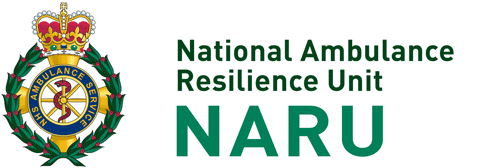After two and half years of operation, most people are now familiar with the fact that NARU acts as a central body, co-ordinating various elements of national resilience work on behalf of NHS ambulance services. We also provide input and advice to various Government departments to ensure that patient care in the pre-hospital environment is at the forefront of any new initiatives.
But what does this actually mean, and what specific areas of work are we actually involved in? We thought it would be useful for NARU eNews readers if we listed some of the key work areas we are responsible for, working with the ambulance service’s national Emergency Preparedness work-streams to deliver them. So here goes:
Training and Education:
- Over 988 candidates & delegates have experienced NARU Education during 2013 alone; the majority have been operational staff who will deliver hands-on patient care.
- A broad range of exercises and workshops have been delivered including Amber II, Treat & Leave MTFA exercises, evaluated national exercises and DELPHI.
- The Education Centre has supported various conferences and has hosted numerous visits, including international guests and the military.
Production and distribution of Standard Operating Procedures (SOPs) and other guidance publications
- Radiation guidance.
- Home Office’s Initial Operational Response (IOR) programme.
- Hazardous Area Response Teams (HART) SOPs and Service Specification.
- MTFA (firearms) Service Specification.
- National Command Guidance.
- National Action Cards for major incidents.
- CBRN Service Specification.
- MERIT guidance.
Resilience products & services – evaluation and procurement
- HART capability – risk assessments and evaluation and procurement of new equipment including Personal Protective Equipment, Breathing Apparatus, specialist incident ground kit, airwave maintenance, medical equipment packs etc.
- HART future vehicle specifications and kit.
- MTFA (firearms) procurement of kit and equipment (PPE).
- Detection, identification and monitoring (DIM) equipment.
Providing clinical input to improve patient care
- Review and clinical input to all SOPs produced, from MTFA through to HART.
- Review of clinical interventions available to specialist teams.
- Involvement in the DELPHI study to provide evidence on equipment required at mass casualty events.
Audit, compliance and assurance
- Trust emergency plans audit.
- CBRN audit of Trusts.
- Development of a national assets database on PROCLUS system.
- Commissioning legal scrutiny of all NARU policies.
Ongoing capture and management of ambulance resilience data
- Ongoing management and development of the national PROCLUS system to meet monitoring requirements and user specifications.
- Using the PROCLUS system to identify lessons for future learning and share best practice.
Working in partnership with other agencies
- Working extremely closely with NHS England to ensure all Health EPRR is aligned to ensure better patient outcomes.
- Working to highlight and deliver interoperability with JESIP, including training input.
- Working with Fire & Rescue and Police to look at ways to procure resilience-relevant items together in a more cost-effective way.
- Creating and fostering excellent links with partner and related agencies abroad.
This is just a snapshot of what NARU does and the work we are involved with is developing all the time. For more details on the full NARU remit contact Keith Prior.
